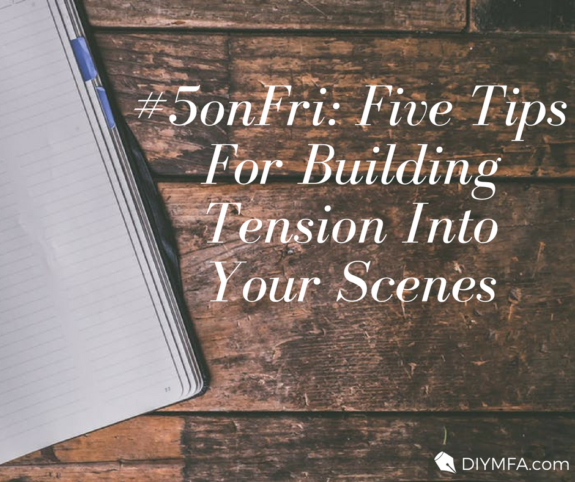One of the key elements to be mindful of when crafting a scene is tension. Think of the scene like a stew. Your characters, plotlines, and conflict make up the “meat and potatoes”, but tension is that little extra spice that brings your scene to life. It’s the line that runs directly from your story to your audience. It is the link that keeps them invested, the draw that appeals to them on an emotional level.
Though something of a paradox, readers want to feel tension so that they can ultimately experience relief. A story that evokes tension is one powerful enough to be considered worth reading.
There are many different ways to evoke tension. Knowing how to add these elements to your story is key to bringing your scene to life. Here are five different ways to evoke tension in your scenes:
1) The Time Bomb
This catchall expression refers not simply to a literal pending explosion, but any time-sensitive event. This can range from something as drastic from the aforementioned explosion to a test deadline. Each and every one of us are familiar with the stress surrounding a race against time. The concept of a “ticking clock” is a great way to keep readers on edge. Some points to keep in mind:
- Provide an “aggravator”; someone who perpetually reminds the protagonist of the approaching deadline
- Emphasize the stakes/consequences of the clock reaching zero: what does the protagonist stand to lose?
2) Information Breakdown
Another classic way to heighten tension is through information breakdown. This occurs whenever a crisis intensifies due to faulty or absent information. A key point to keep in mind is that while the protagonist is kept in the dark, the reader should be privy to either the correct information, or at least to the fact that faulty information has been given. Other points to be aware of:
- Don’t be afraid to allow the characters to deviate down rabbit trails based on faulty info. This will only heighten tension
- Intentional information breakdown, ie lies told by a central character, are an excellent way to build interpersonal tension and to villainize your antagonist
- Consider coupling information breakdown with the “time bomb” effect discussed earlier. Multi-layered tension is extremely effective.
3) Dialogue
Coming right on the heels of information breakdown is dialogue. After all, no one can speak better to the crisis currently at hand than the characters themselves. Arguments, interruptions, and even one-sided telephone conversations are subtle but effective ways to build tension.
As much as possible, have your characters describe the dangers of a situation rather than your narrator. This will keep the reader “down in the trenches” with the characters rather than being pulled back and narrated to. Some important tips:
- Try to keep one character from talking for too long. Monologues tend to drain rather than increase tension
- Arguments/angry outbursts are a great way to relay and reemphasize critical information surrounding a crisis
- Don’t forget about information breakdown! Some of the key instances of this technique will have to come through your dialogue
4) Humor
Perhaps the most ironic or unexpected entry on this list, humor is a surprisingly effective conduit for tension. The logic behind this is fairly straightforward: humor is the antithesis, or direct opposite, of tension. Therefore, it provides an excellent contrast for crisis.
Humor relaxes; it lowers both the characters’ and reader’s suspicions. This allows a sudden plot twist to create an instant spike of tension. Think of humor as something of a red herring: a plot device diverting the audiences’ attention so that a sudden danger comes as a total shock, maximizing tension. Some points to remember:
- High tension scenes can be created by contrasting a light-hearted atmosphere with an impending and unforeseen danger. Picture a group of friends laughing and joking around a table, unaware that a bomb is planted in the room they are sitting in
- Providing your villain with a sense of humor will provide a source of tension as your antagonist will possess the ability to lower others’ defenses/catch other characters off guard
5) Mechanics
Finally, tension in a scene can be increased using good old-fashioned writing mechanics. As strange as it may sound, how you put together a sentence is often more important than the sentence itself.
While composing long, flowing sentences will provide a sense of calm and rhythm, short, choppy sentences will put the reader on edge. Cliffhanger paragraphs, point-of-view shifts, and broken dialogue are all examples of writing mechanics you can employ to build tension. Some helpful hints:
- Make full use of your white space. Sentences orphaned by themselves will stand out like streaks of red, and will carry tense impact
- Consider using onomatopoeia or “sound words” to bring the tension to life. Using words like “thud”, “bang”, and “crack” will enable the reader to feel fully engaged in the heat of the scene
- Fragmented sentences, especially in dialogue, can help reemphasize the crisis
No matter what type of story you are writing, some level of tension will always be necessary. It provides the nervous energy, the rapid page turning, and the edge-of-your-seat suspense that brings your story to life. Take the time to craft tension into your scenes; it is well worth the effort.

Jonathan Vars is a Christian fiction writer from New England, and founder of the writing website voltampsreactive.com. His latest novel “Like Melvin” is currently available on Amazon and Google Books. In addition to writing, Jonathan enjoys running, painting, and trying not to freeze to death in the winter.







